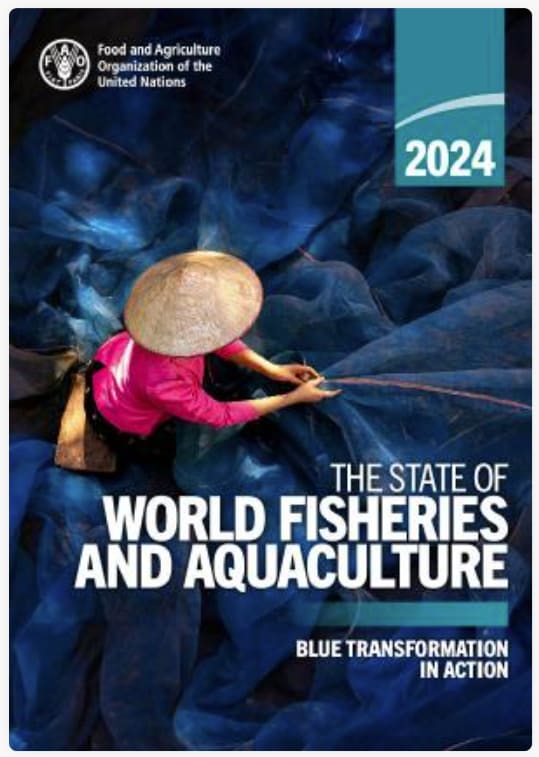
FAO Report: Global fisheries and aquaculture production reaches a new record high
Aquaculture surpasses capture fisheries in aquatic animal production for the first time, The State of World Fisheries and Aquaculture 2024 says
World fisheries and aquaculture production has hit a new high, with aquaculture production of aquatic animals surpassing capture fisheries for the first time, according to a new report from the Food and Agriculture Organization of the United Nations (FAO).
The 2024 edition of The State of World Fisheries and Aquaculture (SOFIA) said global fisheries and aquaculture production in 2022 surged to 223.2 million tonnes, a 4.4 percent increase from the year 2020. Production comprised 185.4 million tonnes of aquatic animals and 37.8 million tonnes of algae.

“FAO welcomes the significant achievements thus far, but further transformative and adaptive actions are needed to strengthen the efficiency, inclusiveness, resilience and sustainability of aquatic food systems and consolidate their role in addressing food insecurity, poverty alleviation and sustainable governance,” said FAO Director-General QU Dongyu. “That’s why FAO advocates Blue Transformation, to meet the overall requirements of better production, better nutrition, a better environment and a better life, leaving no one behind.”
The SOFIA report will be formally launched at the High-level event on ocean action “Immersed in Change” in San Jose, Costa Rica
Aquaculture produces record amount
In 2022 and for the first time in history, aquaculture surpassed capture fisheries as the main producer of aquatic animals. Global aquaculture production reached an unprecedented 130.9 million tonnes, of which 94.4 million tonnes are aquatic animals, 51 percent of the total aquatic animal production.
Aquaculture growth indicates its capacity to further contribute to meeting the rising global demand for aquatic foods, but future expansion and intensification must prioritise sustainability and benefit regions and communities most in need.
At present, a small number of countries dominate aquaculture. Ten of them – China, Indonesia, India, Viet Nam, Bangladesh, the Philippines, Republic of Korea, Norway, Egypt, and Chile – produced over 89.8 percent of the total. But many low-income countries in Africa and Asia are not using their full potential. Targeted policies, technology transfer, capacity building and responsible investment are crucial to boost sustainable aquaculture where it is most needed, especially in Africa.
Global consumption of aquatic foods rises again
Record production of aquatic foods underlines the sector’s potential in tackling food insecurity and malnutrition. Global apparent consumption of aquatic animal foods reached 162.5 million tonnes in 2021. This figure has increased at nearly twice the rate of the world population since 1961, with global per capita annual consumption rising from 9.1 kg in 1961 to 20.7 kg in 2022.
Of total aquatic animal production, 89 percent was used for direct human consumption, underscoring the critical role of fisheries and aquaculture in maintaining global food security. The rest was destined for indirect or non-food uses, mainly fishmeal and fish oil production.
Supporting further consumption from sustainable sources is crucial to foster healthy diets and improve nutrition worldwide. Aquatic foods provide high-quality proteins – 15 percent of animal proteins and 6 percent of total proteins worldwide – and key nutrients including omega-3 fatty acids, minerals, and vitamins. In 2021, they contributed at least 20 percent of the per capita protein supply from all animal sources to 3.2 billion people.
Most capture fisheries production comes from sustainable stocks
Global capture fisheries production has remained stable since the late 1980s. In 2022, the sector produced 92.3 million tonnes, comprising 11.3 million tonnes from inland and 81 million tonnes from marine capture. Despite the growth in aquaculture, capture fisheries remain an essential source of aquatic animal production.
FAO projects rise in production and consumption
SOFIA also contains FAO’s outlook for fisheries and aquaculture, which projects increases in world production and apparent consumption for the period up to 2032.
Aquatic animal production is expected to increase by 10 percent by 2032 to reach 205 million tonnes. Aquaculture expansion and capture fisheries recovery will account for this rise.
SOFIA projects that apparent consumption will increase by 12 percent to supply on average 21.3 kg per capita in 2032. Rising incomes and urbanisation, improvements in post-harvest practices and distribution and dietary trends are expected to drive most of this increase.
However, per capita apparent consumption in Africa will continue to decrease, as production projections may not keep up with population growth. This is especially alarming for sub-Saharan Africa where many countries are dependent on aquatic foods to meet their nutritional needs, particularly animal proteins and micronutrients.
The report also presents a scenario showing the potential implications of population dynamics on
the supply of aquatic animal food up to 2050. Due to the rising global population, to maintain through to 2050 apparent consumption of aquatic animal foods at the 2022 estimated level of 20.7 kg per capita would require an increase in the total aquatic animal food supply of 36 million tonnes, a rise of 22 percent. This highlights the need to accelerate Blue Transformation priority actions in a world where aquatic foods play a more significant role in ending hunger, malnutrition and poverty.
Falling employment but vital livelihoods for millions
In addition to nutrition and food security, fisheries and aquaculture are an important source of livelihoods. According to the latest data, an estimated 61.8 million people were employed in the primary sector of fisheries and aquaculture in 2022, down from 62.8 million in 2020.
SOFIA 2024 in numbers
All figures are from 2022 unless otherwise specified.
Production
- Global fisheries and aquaculture production: 223.2 million tonnes
- Aquatic animals: 185.4 million tonnes
- Algae: 37.8 million tonnes
- Global aquaculture production: 130.9 million tonnes
- Global capture fisheries: 92.3 million tonnes
- Aquatic animal production by region: Asia (70 percent), Europe (9 percent), Latin America and the Caribbean (9 percent), Africa (7 percent), Northern America (3 percent) and Oceania (1 percent)
- Main producers of aquatic animals by country: China (36 percent), India (8 percent), Indonesia (7 percent), Viet Nam (5 percent) and Peru (3 percent)
- Estimated total first sale value of fisheries and aquaculture production: USD 472 billion
- Estimated total first sale value of aquaculture production: USD 313 billion
Consumption
- Global apparent consumption of aquatic animal foods (2021): 162.5 million tonnes
- Global apparent consumption of aquatic foods per capita (2021): 20.6 kg
- Increase in global apparent consumption of aquatic foods per capita: from 9.1 kg in 1961 to 20.6 in 2021
Trade
- Top exporters of aquatic animal products: China, Norway, Viet Nam, Ecuador, Chile
- Top importers of aquatic animal products: The United States of America, China, Japan, Spain, France
- Value of international trade of aquatic products: USD 195 billion
